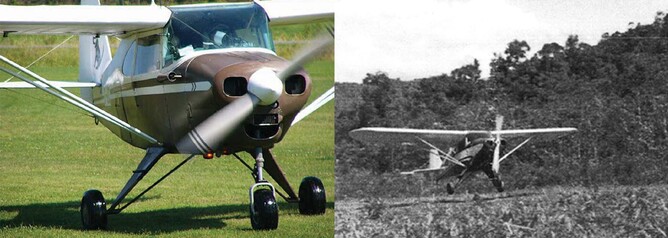It is an unremarkable entry in my Pilot’s Logbook.
November 29th 1963, Piper PA-22 Tri-Pacer, VR-WAY, from Long Akah to Long Tebangan, Passengers Maria and Ubong, Flight time 10 minutes.
But I will never forget that flight as long as I live. It would be the closest I ever went to having an accident, without ‘bending metal’ or ‘scratching’ a passenger.
Joan and I, with Jo-Ann, Elizabeth and baby Penelope, had left Wasua in PNG on 8 December 1962, Max Flavel flying us down to Daru in the Cessna 180, VH-BVJ, to catch the TAA Catalina flying boat for the flight across the Gulf of Papua to Port Moresby. We were beginning our journey to Borneo for our next missionary aviation assignment, a secondment to the Borneo Evangelical Mission (BEM), allowing their two pilots, Bruce Morton and Ken Cooper, to have their furlough in Australia.
We combined our travel with annual leave, having a couple of weeks with our families in Sydney, before making a quick trip to Melbourne to visit the BEM leadership. At the same time we met Ken and Joan Cooper, who by then were having a restful time in accommodation at the Melbourne Bible Institute facilities in suburban Melbourne (my young brother Phillip, brother-in-law Peter Salisbury and I drove to Melbourne in Phil’s VW Beetle).
A few weeks later, Joan, the children and I took a Qantas Boeing 707 flight to Singapore for a stop-over at the OMF headquarters there (with BEM becoming part of OMF’s ministries, it was a good thing for us to meet some of these people). I also made contact with the Airworthiness Regulation Board staff who monitored the airworthiness of the BEM aircraft, as I needed to have my Australian Aircraft Maintenance Engineer (AME) Licenses endorsed so that I could work on these Malaysian registered aircraft.
Interestingly, the very day we left New Guinea, the Brunei Revolt (also known as the ‘Azahari Rebellion’) broke out in northern Sarawak — just where we were headed. All the missionaries had been evacuated to Labuan Island off the south-eastern coast of Sabah (at that time British North Borneo) while British military forces began the process of restoring law and order.
The missionaries were back at most of their stations by the time we arrived — but it was a ‘new’ experience for us, with British soldiers and the Gurkha Regiment deployed to many of the communities and airstrips in the region.
A large part of Sarawak had been declared ‘The Black Area’ and we were not permitted to fly into the airstrips in that region, nor were we permitted to fly over as we travelled to other places. But as time passed, that restriction was eased and, if we gave 24 hours’ notice of our intentions, “permission may be granted for flights over the area and for landings at some of the airstrips”.
Some of the students in the Bible School at Lawas had not been home to their village for more than a year (because of these restrictions), so the Mission asked me to seek permission for several flights to allow these students to have time at home. These flights were approved.
Long Tebangan was an interesting airstrip, requiring ‘one way’ operations because of its location in a narrow valley with a clear approach (and departure path) in only one direction. Added to that was a unique feature where the airstrip incorporated a bridge across a small stream about halfway along its length.
The military authorities gave us permission for the flight but, as we had been unable to make radio contact with the village to learn from them if the airstrip was ‘open’ for normal use, I decided to fly there and make an aerial inspection of the airstrip before landing.
There were a couple of other destinations on the whole round trip and all was going well. Because the airstrip was down in a narrow valley, it wasn’t possible to get down close to it, so I spent a few minutes circling overhead and it seemed to me that the grass in the airstrip was about knee-high, and that on the football field (built across the airstrip) was about ankle high. I satisfied myself that I could make a safe landing and departure — remembering that, as with many of these ‘one way’ airstrips, once you turn onto Final Approach, you are committed to make the landing. There is no way of going round or turning back, you just have to make the landing.
One of the important aspects of landing any aircraft is to ensure that you are flying down the centreline of the airstrip or runway, and keeping the aircraft heading straight in that direction. In judging the height above the ground, and when to make the ‘round-out’, the pilot will be using his peripheral vision.
As I was getting near that ‘round-out’ stage, my peripheral vision was telling me "something is not normal", so I took a quick glance out the side window and saw that, what I thought was knee-high was actually more like waist-deep grass! Very quickly, I opened the throttle and pulled back on the control wheel. The aircraft responded, and as the wheels began to go into that long grass it was in a ‘nose high’ attitude, with a good blast of air from the propeller going over the elevators, holding the tail down and the nose up.
I think we stopped in about 15 feet. I was thrown forward into the shoulder harness — thankfully, we all had our seat-belts securely tightened. I just sat there, knees shaking, waiting a few moments to thank the Lord for keeping us safe.
Very soon, the people from the village (just around the bend in the river at the far end of the airstrip) came to welcome us and to tell me (with their broken English and my broken Malay) that the motor that was used to drive the generator for the radio — the same motor that was used for the grass cutter for the airstrip, was rosak (broken) — hence the difficulty in making radio contact and the reason for the long grass.
The men had brought their parangs (a short sword that no Bornean man was ever without) and what in PNG we called a sarif, a strip of steel used for cutting the grass — and commenced to make a strip of short grass, wide enough for the wheels of the Tri-Pacer, and long enough for me to get airborne so that I could continue the assigned flights for that day.
When I got back to Lawas, there was a letter from the Christian Book Room in Sandakan, and whenever you got a letter from the Willis family — whether it was a ‘bill’ or a receipt, or even books that you had ordered — there would be a nice little card with an encouraging message. This was waiting for me:
PRAYER
The weary ones had rest, the sad had joy
That day and wondered how.
A plowman, singing at his work had prayed
“Lord help them now.”
Away in foreign lands they wondered how
Their words had power.
At home, the Christians, two or three,
Had met to pray an hour.
Yes, we are always wondering, wondering how
Because we do not see
Someone, unknown perhaps and far away,
On bended knee.
F.M.N.
I have kept that card as an important reminder of one aspect of that important day, many years ago, in Borneo.
I have never had anyone ask me what I was doing on the morning of 29 November 1963 — because on that day they had a sudden "burden to pray for me". But I do know that there were many people who did pray for us, all the years Joan and I served with MAF. I thank God for each one of them.
By Ian Stacy
Ed note: And no doubt many people have thanked God, and are still thanking Him, for the great blessing that pilots like Ian Stacy have been to mission aviation (along with their engineers, mechanics and support staff) — especially in those remote mountainous areas with hair-raising take-offs from and landings on short and rough hand-hewn airstrips. While associated with AMT, Ian served as a MAF pilot in PNG (1960-68) and within Australia (1979-98). He wrote about his flying exploits and experiences in A Life of Unwonted Ease – A Mission Pilot’s Story, “principally written for the sake of my children and grandchildren”.
Ian wrote and sent me this article in October 2016 in response to my open request for anyone who would like to contribute to Serving Together. He had finished his book and extracted and modified this portion for me to use. At the time I was grateful, but waited for a suitable opportunity to include it in this magazine. When I heard he was raised to glory in September 2018, I knew the time had come.


